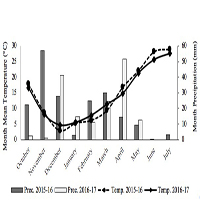Grain yield and associated physiological traits of rapeseed (Brassica napus L.) cultivars under different planting dates and drought stress at the flowering stage

Accepted: 6 October 2020
HTML: 80
All claims expressed in this article are solely those of the authors and do not necessarily represent those of their affiliated organizations, or those of the publisher, the editors and the reviewers. Any product that may be evaluated in this article or claim that may be made by its manufacturer is not guaranteed or endorsed by the publisher.
Highlights
- ES Hydromel as a new hybrid cultivar under late-season drought stress conditions is proposed in cold temperate regions with arid and semi-arid climates.
- Late sowing date has extremely caused a negative effect on the winter rapeseed’s physiological traits during the cold season.
- The result of cluster analysis based on grain yield loss led to the formation of two clusters, which ES Hydromel and ES Alonso with lower yield loss were grouped in the tolerant cluster.
- ES Hydromel in the late planting date and irrigation interruption conditions obtained the lowest stomatal resistance.
- ES Hydromel on regular date and normal irrigation conditions obtained the highest leaf relative water content.
The adverse effects of abiotic stresses have always restricted oilseed crop production, particularly in arid and semi-arid regions. On the other side, global climate change has led us to adapt planting dates and select tolerant cultivars to encounter the new climatic conditions. To evaluate the effect of late-season drought stress under different planting dates on rapeseed cultivars, an experiment was conducted as a factorial split-plot based on randomised complete block design in Karaj region-Iran, during 2015-2017. Planting date and irrigation treatments were considered in the main plots as factorial and cultivars were placed in subplots. Two planting dates were regular date (October 7) (PD1) and late planting date (November 6). Irrigation was also carried out at two levels of normal irrigation (NI) and irrigation interruption from flowering stage onwards. Experimental cultivars included ES Hydromel, ES Alonso, ES Darko, ES Lauren, and Ahmadi. According to the results, late-season drought stress and delayed planting date reduced leaf relative water content (LRWC), total chlorophyll content, proline, and grain yield, and increased stomatal resistance (SR), canopy temperature, and leaf soluble carbohydrates (CLS) in rapeseed cultivars. The highest grain yield (4505.6 kg ha–1) was obtained in NI conditions and PD1. Significant interactions of planting date, irrigation, and cultivar on LRWC, SR, and CLS traits indicated that the ES Hydromel was the most tolerant hybrid cultivar with the highest LRWC and the lowest SR and CLS levels compared to other ones in unfavourable conditions of late-season drought stress and delayed planting. To confirm these results, cluster analysis led to the formation of two clusters, where ES Darko, Ahmadi, and ES Lauren cultivars were placed in the sensitive cluster and ES Hydromel and ES Alonso cultivars were assigned to the tolerant cluster. Therefore, ES Hydromel can be introduced as a superior cultivar to be selected as a genotype that presents acceptable resistance under drought stress and late sowing in arid and semi-arid regions.
How to Cite
PAGEPress has chosen to apply the Creative Commons Attribution NonCommercial 4.0 International License (CC BY-NC 4.0) to all manuscripts to be published.

 https://doi.org/10.4081/ija.2020.1648
https://doi.org/10.4081/ija.2020.1648



